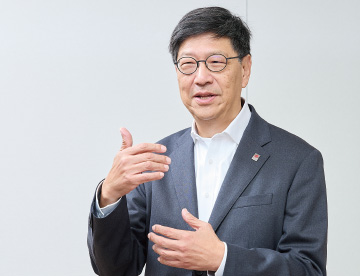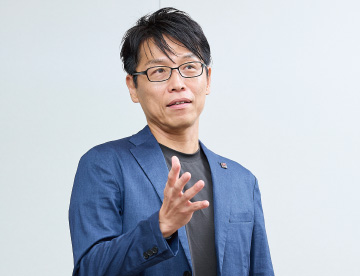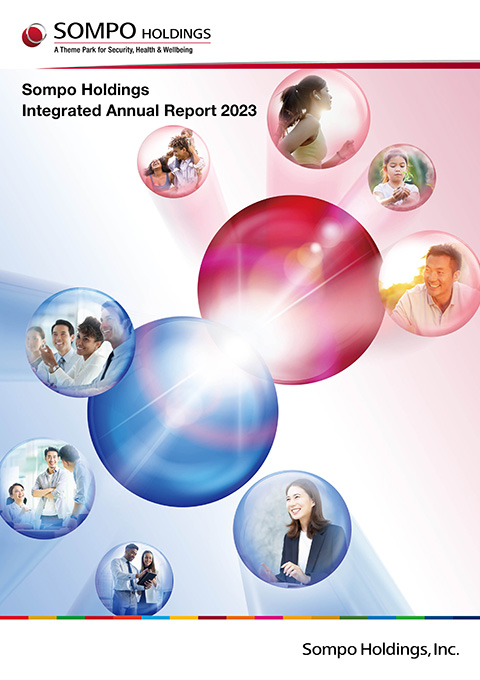
Strategy
Three Horizons of SOMPO’s Digital Strategy
SOMPO’s digital strategy proceeds strategically through three horizons (stages).
Horizon 1, the cornerstone of our digital strategy, focuses on increasing profits by improving operational efficiency and achieving cost reductions through digital transformation (DX) in each SOMPO business unit.
Horizon 2, which looks ahead to the next 3-5 years, aims to create new businesses using data accumulated through DX; that is, to implement a Real Data Platform (RDP).
Horizon 3, which looks ahead to the next 5-8 years, we are considering various possibilities, including how to introduce disruptive technologies such as AI and Web3 into the mainstream to spur the development of new products and services.
In this special feature, the Sompo Group leaders who drive these three horizons summarize the progress and future prospects of these efforts.
 CDOs invigorating DX at SOMPO
CDOs invigorating DX at SOMPO

Albert Chu
Sompo Holdings Group CDO
Akiko Murakami
Sompo Japan Insurance Inc. CDO
Alfred Goxhaj
Sompo International CIO/CDO
Motoyuki Nishikawa
Sompo Himawari Life Insurance CDO
Takahiro Iwamoto
Sompo Care CDO
DX in each business unit

Albert The theme of today’s dialogue is Horizon 1. Our business unit CDOs are key to our Horizon 1 initiatives, so please outline the initiatives you are taking and progress being made.
Murakami In the P&C Insurance Business, our first goal is to achieve sophistication and efficiency in claim payment and underwriting. This is because the impact of natural disasters has become more severe in recent years, and it is anticipated that insurance itself will not be viable if the same costs are incurred as in the past.
Meanwhile, digital technology has become commonplace in our everyday lives. Going forward, we need a system that not only sells insurance online and through sales channels, but also adapts to our customers’ digital behavior and allows them to enroll in insurance as soon as they need it. We must accelerate this behavior shift to online purchasing and create a new insurance purchasing experience. By aiming to create this new digital sales methodology and customer experience, we will streamline our business processes.
Alfred There is a lot of potential in DX but primarily I see it as creating a new business ecosystem that must benefit all stakeholders in the insurance supply chain while maximizing profitability.
Increasing the value of data is key to that end. The insurance business accumulates a vast amount of data, but to reliably maximize profits, data on all insurance products must be integrated and its value augmented with third-party data.
The next challenge is the digitization and speed of business processes. Almost all business processes that are currently touched by human hands or processed by human brains need to be digitized at speed.
The third challenge is reducing complexity. Complexity can slow process, create friction, and cost money. It may seem contradictory, but I believe it is important to implement less technology and more robust technology.
By ‘robust’ I also mean improving mobility so that decision-makers can leverage the value of information wherever they are and whenever they need access to it.
Nishikawa The DX we are tackling at Sompo Himawari Life Insurance has two areas of scope. The first area, which I call “offense,” involves further refining Insurhealth® and further supporting the health of our customers. The second, which I call “defense,” includes streamlining and reconfiguring operations and creating optimal and pleasant customer experiences. During this first year of Horizon 1, we have been reviewing how policy data is managed and exploring ways to explain insurance products using new digital technology. With these activities, I think we are not only producing results in Horizon 1, but also sowing the seeds for results in Horizon 2. Our challenge going forward will be to harvest the fruit from these seeds and use technology and data to deliver real business impact.
Iwamoto At Sompo Care, we are creating a sustainable nursing care system. We therefore started with the ambitious goal of creating a prosperous, long-lived Japan. In the nursing care industry, people of various ages and working styles are passionate about their day-to-day work. Their work is characterized by the need to provide attentive service and keep accurate records at the same time. Since 2017 we have been implementing measures such as centralizing long-term care insurance claims and other administrative tasks and introducing smartphones to document nursing care that occurs on-site. In 2019, we established the Future Care Lab in Japan to begin research on technology and robots that can take over caregiving tasks themselves, such as watching over those who require nursing care. The studies conducted at the lab cover about 200 items per year and are gradually becoming a part of our field operations.
As the birthrate declines and the population ages, by 2040 it is estimated there will be a shortage of 690,000 nursing care workers, so we are actively working on the use of data to achieve operational efficiency while maintaining and improving the quality of care. I believe that by utilizing data, we can contribute to extending healthy life expectancy and reducing social security expenditures by lowering hospitalization and morbidity rates.

Murakami When it comes to data, I see a need for it in all areas. In the P&C Insurance Business, we are promoting the use of data in underwriting.
Sompo Japan Insurance uses Palantir’s “Foundry” on a single information platform to efficiently collect historical loss ratios and various other data, and now it can automatically generate underwriting results for simple cases. In the future, we intend to use that data to achieve more advanced underwriting. Furthermore, when a large-scale disaster occurs, insurance claims from customers are concentrated, but with digitalization, multiple people can simultaneously access information and efficiently proceed with claim payment procedures at the time of the disaster.
CDOs’ visions for the future
Albert Sowing the seeds of DX and reaping the rewards through the business is very exciting to see. Can you please talk about your visions of how you will harvest what you have sown so far?
Murakami The P&C insurance business is in need of a major transformation, and we would like to make a solid contribution to this through digital technology. My vision for the future is not just to digitize one business process, but to transform the business processes themselves by connecting their data. For example, in addition to utilizing historical policy and claim data used in underwriting and results data from insurance payouts, I want to further accelerate datadriven product revisions and underwriting policy revisions by further utilizing this vast amount of data.
My goal is to make this data available to all employees. From account managers all the way up to executive officers and the President, I think it’s important to keep an eye on the data as we proceed with company management and operations. Data connects all of your business processes, which in turn transforms your business processes.
Nishikawa At Sompo Himawari Life Insurance, as we strive to transform into a health support enterprise, a path to success is now in sight. For example, we have clear evidence that the hospitalization rate is reduced by half for customers who use our Get☆Healthy Challenge! program, which lowers your premiums if you get healthier, compared with customers who do not use it. Furthermore, we are constantly upgrading the digital services, or what I call “infrastructure,” to support the Get☆Healthy Challenge! program.
Our next challenge is to make this path to success clearer and wider. Specifically, creating a mechanism for customers to change their behavior towards health makes our customers healthier and establishes our brand as a Health Support Enterprise, which in turn creates a new cycle that brings in new customers. To this end, it’s important to use data to develop Insurhealth® and services that are tailored to each individual, and to create a system that offers them at the time they are needed. At Sompo Himawari Life, combining internal and external data to create this mechanism is a project for Horizon 2, and I believe that this will lead to the realization of a life insurance Real Data Platform.
Iwamoto When it comes to how to achieve a long and healthy life, we need to make full use of data when thinking about where to focus and what can be done. The first idea is to use the data to recognize changes early and link them to early action to avoid hospitalization. The second idea, taking a longer view, is that now that a large number of users’ daily life logs are available, it’s possible to infer a person’s future situation based on the past record of people in similar situations. We are now beginning to explore, trying to do activities that use this inferred information to help prevent aggravation of people’s conditions and support their self-reliance.
Albert That shows the power of data to not only improve the quality of life of our residents, but also the quality of care provided by caregivers. What is your vision for the future of the Overseas Insurance and Reinsurance Business?

Alfred The data is the artery and the blood that provides life to the business. Datadriven decision-making means eliminating subjectivity and making scientific decisions. It should be the key to success and for the company’s future growth. At a simple stage, analyzing the causes and reasons for losses can help us develop a better business. At a more developed stage, a comprehensive analysis of data from multiple sources, both internal and external, is key to increasing profitability and improving the structural strength of the business.
But the data accuracy is just as important. We have implemented what we call the Reconciliation Reporting System. A set of complex reports automatically reconciles all of our transactions on a daily basis and verifies that the information is passed correctly between business applications. It is a system that allows us to notice errors in real or due time by automating and reconciling everything.
CDO alliance
Albert Thank you all. One of SOMPO’s uniqueness is that everyone of us as CDOs has our own vision, points of view and initiatives. We formed the CDO Alliance to harness our combined DX expertise and foster cross-functional collaboration in digital and data. I would like to ask you about the strength of our CDO Alliance collaboration and how we can all contribute to the Group.
Murakami The term “Insurtech” is used to describe technology related to insurance, but if you look at its elements and technologies, it is by no means limited to insurance. For example, many of the technologies, including making decisions by looking at images and interacting with customers using avatars, apply not only to insurance but also nursing care and other fields. I would like to share these technological trends and the results of our PoC (proof of concept) tests within our CDO Alliance.
Alfred The first that comes to mind is sharing ideas and successes. In addition, we can learn a lot from other industries. We have had our fair share of success in the insurance and nursing care industry, but there is only so much we can take or learn from these industries. We should learn from other industries, incorporate the lessons from them into our solutions, and evolve them. I believe this will open up an even greater horizon for us.

Nishikawa One nice thing about the CDO Alliance is that it lets us simulate the successes and failures of other businesses’ efforts, learn from them, and apply them to our own efforts. Another is that we can cooperate in the development of human resources. If we can learn what others are doing through exchanges among members working on DX in each business unit and bring those ideas back to our own companies and develop them, we can create an environment that enables faster progress in human resource development.
Iwamoto If you want to start using generative AI, for example, it should be possible to share know-how and examples pertaining to the health of seniors between the nursing care and life insurance businesses. I hope that such ideas will be discussed and fleshed out within the Alliance, and I look forward to working on them together.
Albert As another important perspective, what do you think could be done to reach out and promote digital transformation to our colleagues who work in areas other than our digital department?

Iwamoto It’s not easy to get people to use a digital device just by saying “Here, use this.” However, when you tell them, “Using this will bring such-and-such benefits to the users you are in charge of,” they will be more likely to use it. We need to learn the power of communication.
Nishikawa The reason why people use digital is that there is some problem that needs to be solved in the field. I think we need to demonstrate that the digital solution is effective at solving their problem, no matter how small it may be.
In that sense, the ability to communicate, as Mr. Iwamoto mentioned earlier, is also important. The magic formula is to create a number of small successes to give them a sense of purpose and accomplishment.
I think it’s important to solicit ideas from everyone and inspire a movement under the banner of “Let’s try something, it worked, let’s do it again!”
Alfred In our case, it’s been a little bit different. The culture in our company is that people are insatiable when it comes to technology. They can’t have enough. The problem is that technology doesn’t solve every business problem. We try to make AI especially, work on the most difficult problems, but we also highlight them that it can be risky if not used properly. Another problem in our side in the digital department is what to pick, what to choose, how to attack the area where the benefits are the greatest. We are past the stage of impressing upon users that technology is great. We are at the stage where teaching them that it is risky if they don’t comply with regulations and compliance.
Murakami Listening to Alfred, I was thinking that the problem is that people don’t want to change what’s working right now.
To overcome that barrier, we need to lower the barrier to having machines do part of the process for simple cases. This will free up time for people to work on the more difficult cases and higher value-added work. It’s possible that AI will do very advanced things in the future, but it is important to build trust that people with expertise will ultimately confirm whether it is correct and that technology will be integrated and utilized in a way that ensures that people are doing the things that only people can do.















